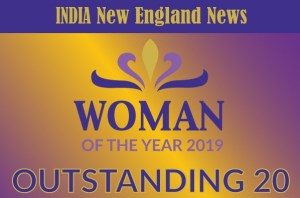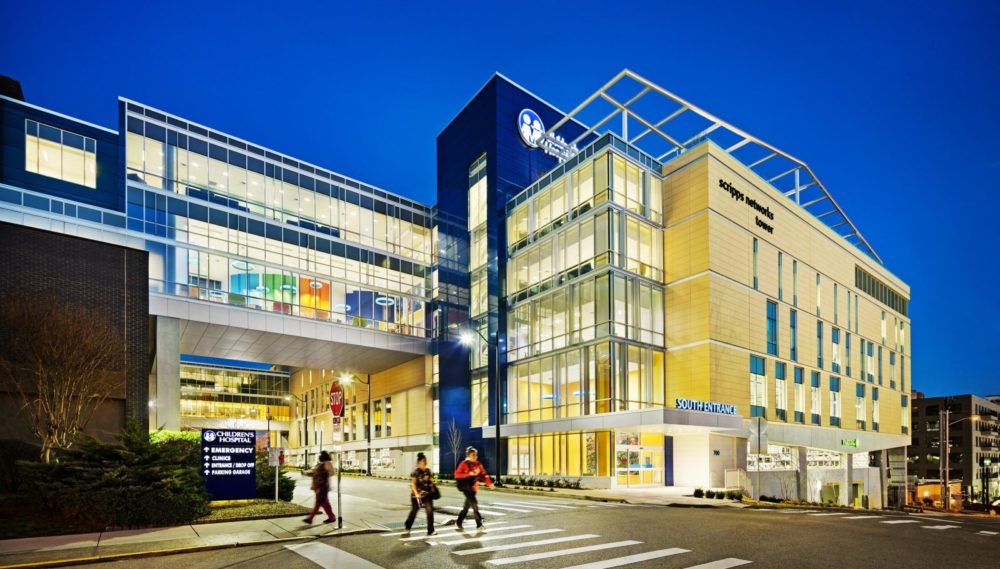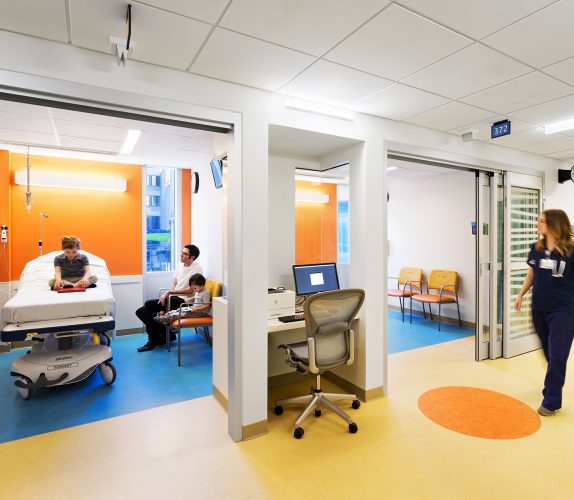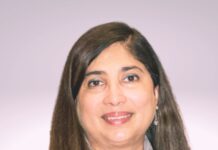BOSTON–Uma Ramanathan, AIA, LEED AP, is a principal at Shepley Bulfinch, a Boston based architectural firm where she has been for 27 years. As Shepley Bulfinch’s leader in pediatric healthcare, Uma has led recent projects for Boston Children’s Hospital, Children’s Hospital of Michigan, East Tennessee Children’s Hospital, and Women and Children’s Hospital of Buffalo.
Her grasp of the rigorous demands of medical staff has been invaluable to her clients, as is her ability to work effectively with high-level medical faculty and administrators to build consensus among diverse viewpoints. She was awarded the 2018 BSA Women in Design, Award of Excellence.
 As a Principal at Shepley Bulfinch, Ms. Ramanathan specializes in programming, planning, and conceptualizing facility needs by addressing complex issues in healthcare operations. One of her largest contributions in New England has been to the Boston Children’s Hospital (BCH) community, where she has worked tirelessly with its’ leadership and the Department of Public Health to ensure innovation within a conservative, academic, medical mindset. Her guidance and education have made a lasting impact with projects such as the Main South Building—which put BCH back at No. 1 on the list of top children’s hospitals in the nation—and the Hale Family Building, currently under construction.
As a Principal at Shepley Bulfinch, Ms. Ramanathan specializes in programming, planning, and conceptualizing facility needs by addressing complex issues in healthcare operations. One of her largest contributions in New England has been to the Boston Children’s Hospital (BCH) community, where she has worked tirelessly with its’ leadership and the Department of Public Health to ensure innovation within a conservative, academic, medical mindset. Her guidance and education have made a lasting impact with projects such as the Main South Building—which put BCH back at No. 1 on the list of top children’s hospitals in the nation—and the Hale Family Building, currently under construction.
Her understanding of group dynamics helps Ms. Ramanathan influence healthcare planning and its’ effects on the way people work in a built environment. She encourages designers and users to create a cohesive operational flow to assess and identify areas for improvement. Uma believes that Design must satisfy the current rigorous demands and improve throughput while increasing patient comfort and care giver efficiency. The design process must engender goodwill and participation among all stakeholders. In addition to working with clients in healthcare planning, one of Ms. Ramanathan’s pet projects was the development of a software package used to generate health facility space programs.
 Her two terms on the Alumni Board at the University of Michigan’s Taubman College of Architecture and Urban Planning are a testament to her commitment to future generations of healthcare architects and evolved into the development of the College’s Healthcare Studio. Her contributions include participation in BSA’s Healthcare Facilities Committee, serving on the Board of Overseers for the Franciscan Children’s Hospital, and being a guest lecturer for the Boston University School of Public Health. She additionally enjoys her voluntary role as a Design Advisor for several temples in the New England area and as a AIA Design awards jury member.
Her two terms on the Alumni Board at the University of Michigan’s Taubman College of Architecture and Urban Planning are a testament to her commitment to future generations of healthcare architects and evolved into the development of the College’s Healthcare Studio. Her contributions include participation in BSA’s Healthcare Facilities Committee, serving on the Board of Overseers for the Franciscan Children’s Hospital, and being a guest lecturer for the Boston University School of Public Health. She additionally enjoys her voluntary role as a Design Advisor for several temples in the New England area and as a AIA Design awards jury member.
Here is a Q/A with Ms. Ramanathan:
INDIA New England News: Please tell our readers about your work and what you enjoy most about it?
Uma Ramanathan: Growing up, as a daughter of a successful residential building developer I have been exposed to the building industry for a long time and was always fascinated with the idea of creating effective spaces for people. Influenced by my father’s interest in the people for whom he was building rather than the business side, I have always focused on design for community building. In graduate design studio in University of Michigan I was introduced to American Architects. Frank Lloyd Wright is one of the architects I admire and appreciate most especially his unbuilt architecture for the community.
I am very interested in pediatric care especially identifying and implementing strategies for improving healthcare delivery for children. My passion for designing for women and children goes back to a very personal experience as a young mother facing my daughters’ challenges during her first three weeks in Neonatal Care unit. She had outstanding neonatologists who were trying to provide the best possible care in an extremely deficient environment. This experience channeled my self-set trajectory to make better environments for people during their time of need.
I enjoy pushing design boundaries while questioning how institutions should deliver care and improve health. For me it’s not just about creating a beautiful building, but about bettering outcomes and creating functional spaces that work now and in the future. This foresight into planning and design helps clients adapt and advance, while challenging every member of my team to think outside the box and to exceed their own expectations.
 My passion for benchmarking and research is core to advancing design. There is in-depth evidence and intention behind each of my design recommendations to help transform the delivery of care for future generations. My motto is that when you care for a child, you’re really caring for the whole family.
My passion for benchmarking and research is core to advancing design. There is in-depth evidence and intention behind each of my design recommendations to help transform the delivery of care for future generations. My motto is that when you care for a child, you’re really caring for the whole family.
INE: To what charitable, community and professional groups do you belong and why?
UR: I was on the Alumni Board at the University of Michigan’s Taubman College of Architecture and Urban Planning for two terms. This opened the door for me to influence and contribute to the education of future generations of healthcare architects and led to the development of the College’s Healthcare Studio.
I have recently started serving on the Board of Overseers for the Franciscan Children’s Hospital. Their purpose is to advocate post-acute healthcare, pediatric behavioral health programs, and education for children with special needs to Boston’s most philanthropically-inclined individuals.
I enjoy being a guest lecturer for Boston University’s School of Public Health, and as the Design Advisor for Shri Dwarkamai Shirdi Sai Baba Temple, Boston Sri Kalikambal Shiva Temple, and Sri Lakshmi Temple, all in the New England area.
 INE: What are your hobbies and interests?
INE: What are your hobbies and interests?
UR: My penchant for clean surrounding makes me constantly organize my home and results in me donating unused items to the veterans’ association.
I like travelling to places with historical significance as I am curious about their history, culture and what makes them tick. I especially enjoy personal experiences that involve local foods and markets. I believe the food and markets are the soul of the place and a reflection of each culture. I am a great listener and a people watcher, so I go to the market to watch life, listen to the sounds, and experience the character of a place.
INE: In what way you feel you have most positively influenced or served the local community or your company/organization and professional field?
UR: One of my largest contributions to the New England region is the Boston Children’s Hospital (BCH), which I already spoke about earlier.
By designing the new Clinical Care Tower, I have made the organization think about the next generation of pediatric care providers and the future of pediatric medicine. Children’s’ hospitals have become incubators for hospital design innovation and I feel privileged to have had the opportunity to contribute to the future of several nationally reputed ones.
The spaces that architects create affect the well-being of people who use this space: the physical, emotional, psychological, and their spiritual life. The experience of people as they move through space is what creates memory which lasts forever. To create spaces that leave lasting memories requires discipline, technical expertise and a relationship responsibility. For me, relationship building is key to the success of any design project. My team is commissioned to design buildings yes, however the client is often counting on the design project to be a catalyst for change in the organization. This is the unspoken goal of the project that I become responsible for and am able to influence.
INE: What is the most pressing issue that you believe women are facing today?
UR: In 1987 as a recent graduated from UMich, I was greeted by an unwelcoming profession that would not embrace a diverse workforce. The profession has come a long way since I joined Shepley Bulfinch – a stronghold of male architects evolved to a women owned firm under the leadership of Carole Wedge — a true commitment to diversity and women empowerment.
That being said the worldwide challenge is the dichotomy of having to choose between family and career. In my mind if you separate the two, you will always have to make a choice. One will always suffer, and it doesn’t need to be that way; in life everything matters.
INE: What is your rare talent that people don’t know about?
UR: I am a quiet leader and mentor. Most individuals aren’t aware of being mentored. I consider all young people to be better than me. They have access to a lot more information and resources in this digital age. The only thing lacking is experience. Patience and willingness to empower are talents that I bring to the table whether it is in organizing a community retreat for fifteen hundred people or leading a billion-dollar project.
INE: What are your favorite books?
UR: It changes with time and I don’t have one book as “Living Life” is what I read/learn every day.
INE: What are your favorite quotes that motivate you or make you smile?
UR: “I have not studied with the view of making money by my profession; rather, I have held that a slight fortune with good repute is to be pursued more than abounding wealth…” Marcus Vitruvius Polio, First Roman Century, B.C.
“(It doesn’t matter) how intelligent you are, how well off you are, or how well-connected you are. Your perseverance, your courage – if you keep that intact, such people will always be successful” Sudha Murty, 21st “Common Era” Century
INE: Who inspires you the most?
UR: Simplicity, patience, compassion – three strengths that my father was all about. We come from a background that has a solid value system – the main reason why making money did not take over our lives. Living a simple life was key to finding the opportunity to be compassionate in different ways.
It was very important to him that we should be who we are, playing multiple roles as a daughter, wife, mother, mentor, leader and not who someone else wants us to be. He always believed in finding ways to overcome challenges and removing negativity around us and believing in ourselves. In his mind parents, are the best example for kids.
My daughter and her success has also been a big inspiration to make a better place for the extremely vulnerable population – sick children and their families.
INE: Who is the one person you would like to meet and why?
UR: An eminent author, entrepreneur and a professional philanthropist, Sudha Murthy is someone I would be very enthusiastic about meeting. She was the first female engineer to be hired by the largest Telcom company – a company that had restricted women from applying for a job, breaking gender bias. There are many people who label women dressing in traditional clothes as ‘cattle-class.’ Sudha holds her own on the thought that one does not acquire class by possession of money or expensive western clothes.
INE: What are your core values that you try to live by?
UR: In an ever-evolving world we always face countless external pressures and as architects I believe we bring unique skills to be able to innovate and design environments that build communities. I always encourage my teams to stay the course to bring a holistic approach to every project. I believe it is extremely important to empower the next generation to make decisions by giving them space to grow. Everybody individually requires space, I can’t occupy some ones else’s space, I should respect it. Too much of space and you risk growing apart; too little, and we risk suffocating the other person. I need space too. This is my marathon and I run it at my pace – I can’t run someone else’s marathon as this is no competition.














